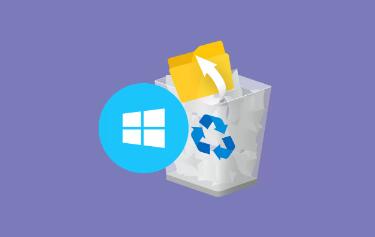The Recycle Bin acts as a temporary storage area for deleted files. When you delete a file, it isn’t immediately removed from your hard drive; instead, it is moved to the Recycle Bin. Here, you can easily restore it if needed. However, once you empty the Recycle Bin, the files are marked for deletion, and recovery requires additional steps.
Method 1: Restore from Recycle Bin
Step 1: Open the Recycle Bin
Double-click the Recycle Bin icon on your desktop.
This will open the Recycle Bin window where all deleted files are displayed.
Step 2: Locate the Deleted File
Browse through the files or use the search bar at the top right corner to find the specific file you want to recover.

Step 3: Restore the File
Right-click on the file you wish to recover.
Select “Restore” from the context menu.
The file will be restored to its original location.
Method 2: Use File History
If you have enabled File History in Windows 11. you can recover older versions of files, including those deleted from the Recycle Bin.
Step 1: Open Settings
Click on the Start menu and select “Settings.”
Go to “Update & Security” and then “Backup.”
Step 2: Restore Files Using File History
Click on “More options” under the “Back up using File History” section.
Select “Restore files from a current backup.”
Browse through the backups to find the deleted file.
Select the file and click the green “Restore” button to recover it.
Method 3: Using Windows Restore Points
If you have System Restore enabled, you can restore your system to a previous state, which may include the files deleted from the Recycle Bin.
Step 1: Open System Properties
Search for “Create a restore point” in the Start menu and select it.
This will open the System Properties window.
Step 2: Initiate a System Restore
Click on the “System Restore” button.
Follow the prompts to choose a restore point from before the files were deleted.
Confirm the restore process and wait for it to complete.
Method 4: Recovering Using Third-Party Data Recovery Software
If the files were deleted from the Recycle Bin or if you have no backup, you may need to use third-party data recovery software. Here’s how:
Step 1: Choose a Data Recovery Software
Popular options include:
Panda Assistant is an innovative data recovery software designed to help users effortlessly recover lost or deleted files from various storage devices, including hard drives, USB drives, and SD cards. With a user-friendly interface, Panda Assistant makes the recovery process accessible to both tech-savvy users and novices alike.
Equipped with advanced scanning algorithms, the software can detect and retrieve a wide range of file types, including documents, photos, videos, and audio files. Whether you’ve accidentally deleted important files, formatted a storage device, or experienced data loss due to system crashes, Panda Assistant provides a reliable solution to restore your valuable data.
Step 2: Install and Run the Software
Download and install the chosen software.
Open the application and follow the setup instructions.
Step 3: Scan for Deleted Files
Select the drive where the deleted files were located (usually the C: drive).
Start a scan to search for recoverable files.
Depending on the software, you may have the option for a quick scan or a deep scan. The deep scan takes longer but is more thorough.
Step 4: Preview and Recover Files
Once the scan is complete, you’ll see a list of recoverable files.
Use the preview function to find the specific files you need.
Select the files and choose the recovery option. Be sure to save them to a different drive to prevent overwriting other deleted files.
Method 5: Professional Data Recovery Services
If the above methods do not work, you may need to consider professional data recovery services. These services can be costly but are often the most effective way to recover lost data.
Step 1: Research Data Recovery Companies
Look for reputable data recovery services with good reviews.
Ensure they have experience with the type of recovery you need.
Step 2: Consult with Professionals
Contact the service and explain your situation.
They may offer a free consultation or diagnostic service to assess your situation.
Step 3: Follow Their Instructions
Follow the company’s instructions for sending your hard drive or device for recovery.
Be prepared for potential costs associated with the recovery process.
Tips for Preventing Future Data Loss
Regular Backups: Use Windows File History or other backup solutions to regularly back up your files.
Cloud Storage: Consider storing important files in cloud services like OneDrive, Google Drive, or Dropbox for additional protection.
Be Cautious with Deletion: Always double-check before deleting files, especially using Shift + Delete, as this bypasses the Recycle Bin.
Recovering deleted files from the Recycle Bin in Windows 11 is straightforward if the files are still present. However, if they’ve been permanently deleted, various methods, including using built-in features like File History, System Restore, and third-party recovery software, can help. If all else fails, professional data recovery services are a viable option. Regular backups are crucial to minimize the risk of data loss in the future.
About us and this blog
Panda Assistant is built on the latest data recovery algorithms, ensuring that no file is too damaged, too lost, or too corrupted to be recovered.
Request a free quote
We believe that data recovery shouldn’t be a daunting task. That’s why we’ve designed Panda Assistant to be as easy to use as it is powerful. With a few clicks, you can initiate a scan, preview recoverable files, and restore your data all within a matter of minutes.
Subscribe to our newsletter!
More from our blog
See all postsRecent Posts
- Hard drive recovery denver reddit 2025-02-28
- How to recover a deleted slide in powerpoint? 2025-02-27
- How to recover deleted capcut videos? 2025-02-27










